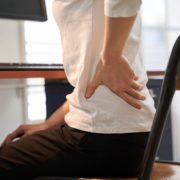Think You’ve Got Piriformis Syndrome? It Might Actually Be Sciatica
Think You’ve Got Piriformis Syndrome? It Might Actually Be Sciatica
A reader of this column recently wrote to me with the following question:
“I’m getting Physical Therapy for lower back pain and sciatica that is said to be from ‘piriformis syndrome’. My PT treatment has consisted of various exercises and some massage. Eight sessions in and no change at all. I’m still having pain when sitting or walking a distance. What now? Do I need an ultrasound or MRI to see if there is any damage or tear to my piriformis? Should I get an injection?”
When I hear something like this, my first thoughts are that either the diagnosis has been missed – or the treatment plan is all wrong – because you absolutely should be seeing some progress and results after 8 sessions of quality physical therapy.
Is it really piriformis syndrome – or is it sciatica?
These two conditions are frequently confused and all too often interchanged. The reality is, piriformis syndrome is far less common than you might think. In fact, research suggests piriformis syndrome is often misdiagnosed and may account for only 6–8% of all cases of sciatica-like symptoms (Boyajian-O’Neill et al., Am Fam Physician, 2008).
What’s the more likely reason for your radiating leg pain? That it’s coming from your lower back, not your piriformis.
Sciatica is a symptom – not a diagnosis
Sciatica refers to pain that radiates down the leg along the sciatic nerve. It can stem from a number of causes, but the most common – by far – is a mechanical problem in the lumbar spine. Things like a bulging disc, joint dysfunction, or even a poorly moving vertebra can irritate or compress a nerve root and cause sciatic pain.
Piriformis syndrome, on the other hand, involves the piriformis muscle compressing the sciatic nerve as it passes through the buttock. This can happen, but true cases are very rare – and diagnosing it correctly requires a process of elimination that most general practitioners and physical therapists don’t have the training to perform correctly.
Why mechanical diagnosis matters
Mechanical diagnosis matters because 80% of all musculoskeletal problems – including sciatica – are due to mechanical causes. And if you don’t take someone through a proper and thorough mechanical exam you will not be able to accurately diagnose the source of your sciatica. This is very likely what happened in this reader’s case.
A mechanical specialist will take you through repeated movements designed to map your symptoms and confirm specific responses to movement. This involves testing how your symptoms respond to specific repeated movements – like bending forward, arching backward, or twisting – and tracking which movements improve or worsen your pain. This is the only way to truly diagnose a mechanical pain issue. MRI’s and X-rays can’t detect mechanical pain problems – which is why they often lead to misleading diagnoses when used too soon.
Without a proper mechanical exam, treatment becomes a guessing game. Massage therapy, stretching, dry needling, and general exercises aimed at loosening your piriformis might feel good temporarily, but they won’t solve the problem if the issue is coming from your spine. Research shows that when mechanical diagnosis and therapy is applied correctly, it’s highly effective at resolving back and leg pain – even in cases that have failed previous treatment (May et al., J Man Manip Ther, 2006).
What to do if PT isn’t working
Let’s say your therapist did perform what they believe to be a thorough mechanical evaluation and still thinks it’s piriformis syndrome. And yet, you’ve gone through 8 sessions and feel no better.
This is a red flag for me.
In my clinic, we expect to see at least some change by session 4 or 5 – even if it’s small. If you’re not seeing meaningful progress by then, it’s time to reassess. That doesn’t necessarily mean it’s time for imaging or surgery. It may simply mean you need a different approach – or a more specialized provider.
A mechanical back pain specialist can help
When it comes to distinguishing between true piriformis syndrome and sciatica caused by a spinal issue, no one is better equipped than a mechanical back pain specialist.
These clinicians are experts at figuring out where your pain is coming from and what movement strategies will actually help you.
They don’t rely on vague diagnoses or cookie-cutter treatments. They use a methodical approach based on how your body responds to specific, repeated movements – and this approach has been shown to be highly effective for resolving back pain and sciatica.
The bottom line?
Piriformis syndrome is real – but very rare. If you’re dealing with leg pain, numbness, or tingling and have been told it’s from your piriformis, there’s a good chance it’s actually sciatica from a mechanical problem in your back. And that’s good news – because it means there’s often a clear and natural solution.
Find someone who specializes in mechanical diagnosis, and you’ll be one step closer to getting answers – and finally getting some relief.
Dr. Carrie Jose, Physical Therapy Specialist, and Mechanical Pain Expert, owns CJ Physical Therapy & Pilates in Portsmouth, NH, and writes for Seacoast Media Group. If local to Portsmouth, NH, and looking for help – request a FREE Discovery Visit with one of her Specialists by CLICKING HERE.



